Chapter 4 Question
8. Galileo's observations and the heliocentric model
Galileo observed
phases
of Venus much like phases of the moon. In particular, he saw
a gibbous Venus. A gibbous phase is only possible if Venus
goes behind the Sun, which is predicted in the heliocentric model.
In the Ptolemaic system, Venus is always in front of the Sun and is therefore
always in crescent phase.
Textbook
Figure 4-14: Heliocentric model
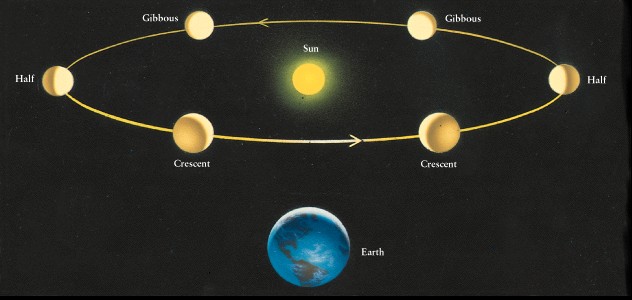
Textbook
Figure 4-15: Ptolemaic model
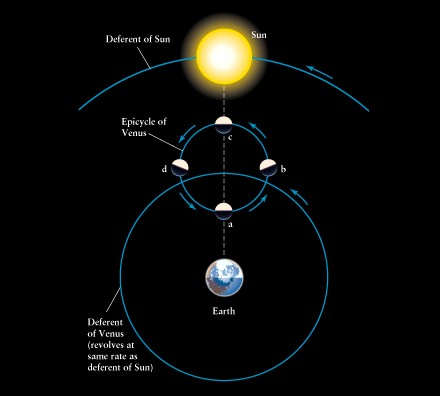
Chapter 4 Question
12. Satellite around the Sun
P2 =
a3 P in years, a in AU
Perihelion = 0.5
AU
Aphelion = 3.5 AU
Major axis = 0.5
+ 3.5 = 4 AU
Semimajor
axis = a = 2 AU
P = sqrt(a3)
= 2.8 years
Chapter 4 Question
16. Force of gravity between earth and moon

G = 6.67x10-11
Nm2/kg2
m1 =
7.35x1022 kg
m2 =
5.98x1024 kg
R = 384,400 km =
3.844x108 m
F = 1.98 x 1020
N
The Sun-Earth force
is 3.53 x 1022 N, or 178 times stronger.
Chapter 4 Question
26. Geosyncrhonous orbit
(a) To stay over
the same place on earth, the satellite must orbit at the same rate the
Earth turns -- once every 24 hours. A slight adjustment to this is
the fact that 24 hours is a mean solar day and we would count one full
rotation of the satellite with respect to the background stars, or the
sidereal day: 23hr 56m 4.091s. Since
the book's answer is 24 hours, lets count either as OK.
(b) How big is the orbit? I intended this to be solved with Newton's form of Kepler's 3rd law. Unfortunately, I never told you the units of Newtons can be broken up into kg m/s2. This probably made it hard for many of you to get the units right. Also, though I happen to know most satellites have masses around 1000 kg, most of you probably don't. However, you might have been able to guess that any satellite is very small compared to the Earth, so when added to Earth's mass in the formula, it doesn't make any difference.
Or about 11% of
the way toward the moon.
Another way to solve this problem is to use P2 = a3 but express instead of using units of years and AU, as for the case of objects around the Sun, use sidereal months and trhe distance between the earth and moon.
(c) The orbit of the satellite lies in a plane. If that plane is inclined relative to the plane of the equator, the satellite will move north and south along a longitude line.
Chapter 4 Question
28. Weight on Mars.
Appendix 2 gives
the answer in the surface gravity column: you would weigh only 38% of what
you would on Earth. Another way to solve this question is to calculate
the force of gravity you feel on Earth and on Mars. The force of
gravity is defined as your weight.
or F = 980 N.
You can apply the same formulae to Mars
(using the diameter and mass listed in Appendix 2):
or F = 370 N. The ratio of your
weights on the two planets is (370 N)/(980 N) or 38%.
Chapter 5 Question 1. How many times does a light beam travel around the Earth in one second?
That means we need to know the circumference of the Earth. The diameter of earth is d = 12756 km. Circumference, pd = 40074 km or 4 x 107 m. What we want to know is how many circumferences light travels in one second. We can do this as a units problem:
1 circumference =
4 x 107 m
c = 3 x 108
m/s
c = 3 x 108m/s
/ (4 x 107 m/circumference)
c = 7.5 circumferences
per second.
Light goes around the Earth 7.5 times in one second.
Chapter 5 Question
4. Wavelength to frequency: n
= c/l
c = 3 x 108
m/s
l
= 825 nm = 8.25 x 10-7 m
n
= 3 x 108 m/s / 8.25 x 10-7 m
n
= 3.64 x 1014 Hz
Compare to the clock
speed of your computer: 400 x 106 Hz.
Chapter 5 Question
5. Frequency to wavelength, n
= c/l
c = 3 x 108
m/s
l
= ?
n
= 89.9 Mhz = 8.99 x 107 1/s
l
= c/n
l
= 3 x 108 m/s / 8.99 x 107 1/s
l
= 3.37 m
Chapter 5 Question 12. Rutherford's experiment in 1910 showed that some energetic particles bounced when they were aimed at gold foil. Since the average density of the foil was not high enough to deflect the particles, Rutherford concluded that there must be very dense particles in the gold foil. He called these particles nuclei. in order for the average density to work out, the rest of the foil must be mostly empty space.
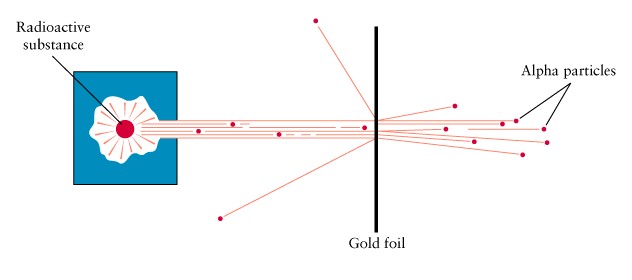
Chapter 5 Question
24. Absorption lines and chemical content
The wavelengths
588.99 nm and 589.59 nm can be found on the energy level diagram on page
123 of the textbook. This is a diagram for sodium (Na). The
presence of these lines in the sun's spectrum shows that there is sodium
in the sun. In particular, since we see the lines in absorption,
the sodium must be part of the cooler, outer parts of the sun's atmosphere
through which the rest of the sun's light shines.
Chapter 5 Question
25. Energy to wavelength
E = hv (think
sneeze)
n
= c/l (from
book)
E = hc/l
l
= hc/E
h = 6.625
x10-34 J s = 4.135 x 10-15 eV s
c = 3 x 108
m/s
E = 511 keV
= 5.11 x 105 eV
l
= (4.135 x 10-15 eV s) (3
x 108 m/s) / (5.11 x 105 eV)
l
= 2.43 x 10-12 m = 2.43 x 10-3 nm
This is very short
wavelength radiation compared to optical light which is 400--700 nm.
These 511 keV photons are X-rays.
Chapter 6 Question
2. Refracting telescope
A refracting telescope
uses two lenses to collect and magnify light. The objective lens
has a large diameter, the eyepiece lens a small diameter. The objective
and eyepiece lenses are positioned relative to each other so that the image
formed by the objective lens falls at the focal point of the eyepiece lens.
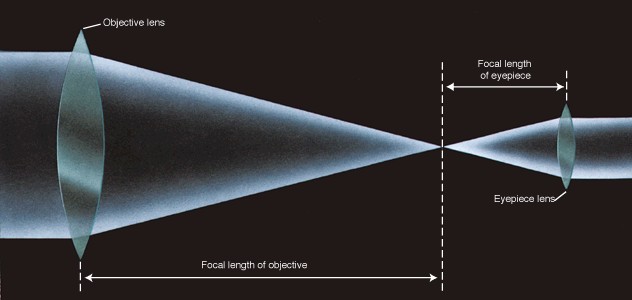
Chapter 6 Question
4. Reflecting telescope
A reflecting telescope
is similar to a refracting telescope in that two focussing elements are
used. In the case of the reflecting telescope, the first element
is a curved mirror instead of a lens. The eyepiece of a reflecting
telescope can be at the focus of the primary mirror (prime focus--panel
b in figure), but such a the telescope would have to be very large.
To avoid having the observer block the incoming light, a Newtonian telescope
uses a small mirror to divert the light (panel a). An variation on
the Newtonian design in the Cassegrain focus, which aims the light through
a hole in primary. An additional mirror can be added to a Cassegrain
arrangement to beam the light out of one of the rotation axes of
the telescope. This is a coude focus arrangement (panel d).
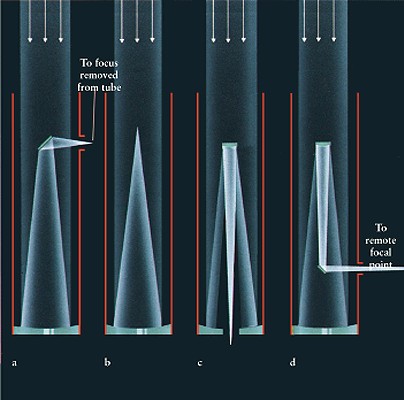
Chapter 6 Question
13. ' Windows' in the atmosphere
The optical and
radio windows refer to regions in the electromagnetic spectrum where the
atmosphere is transparent. The atmosphere is opaque to X-ray ultraviolet
radiation, so there are no 'windows' for these wavelengths. These
wavelengths must be observed from above the atmosphere.
Chapter 6 Question
15. Upside-down images
Using the figure
for chapter 6 problem 2, note that the beams of light from the top and
bottom of the objective lens cross at the focal point of the lens.
Thus a portion of the image that was above another portion of the image
is now below it. In other words, the image is now upside-down.
The same effect can be observed with a magnifying glass: hold the lens
close to your eye and gradually move it away. At first the image
is right side up. Then, at a certain point, the image flips.